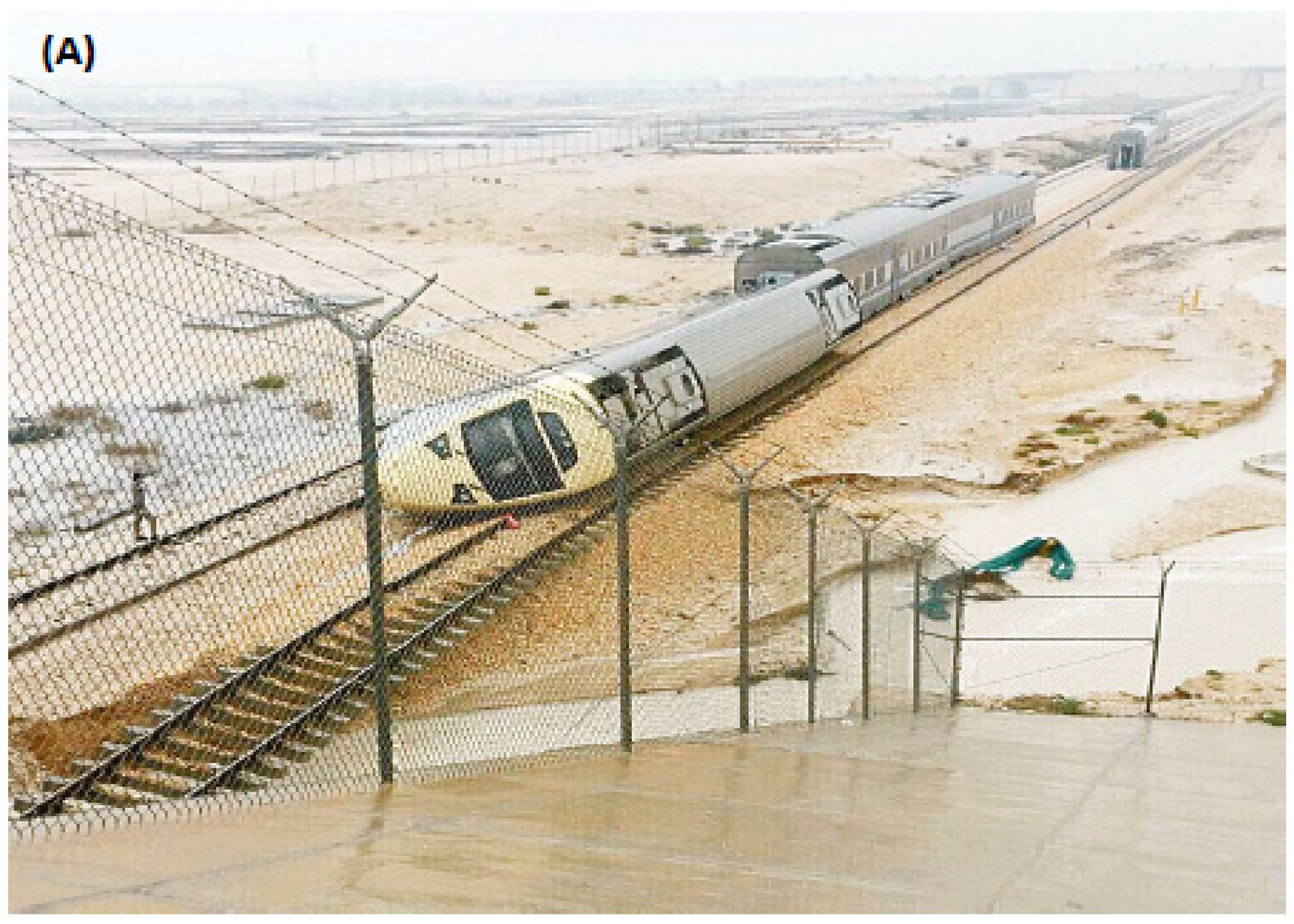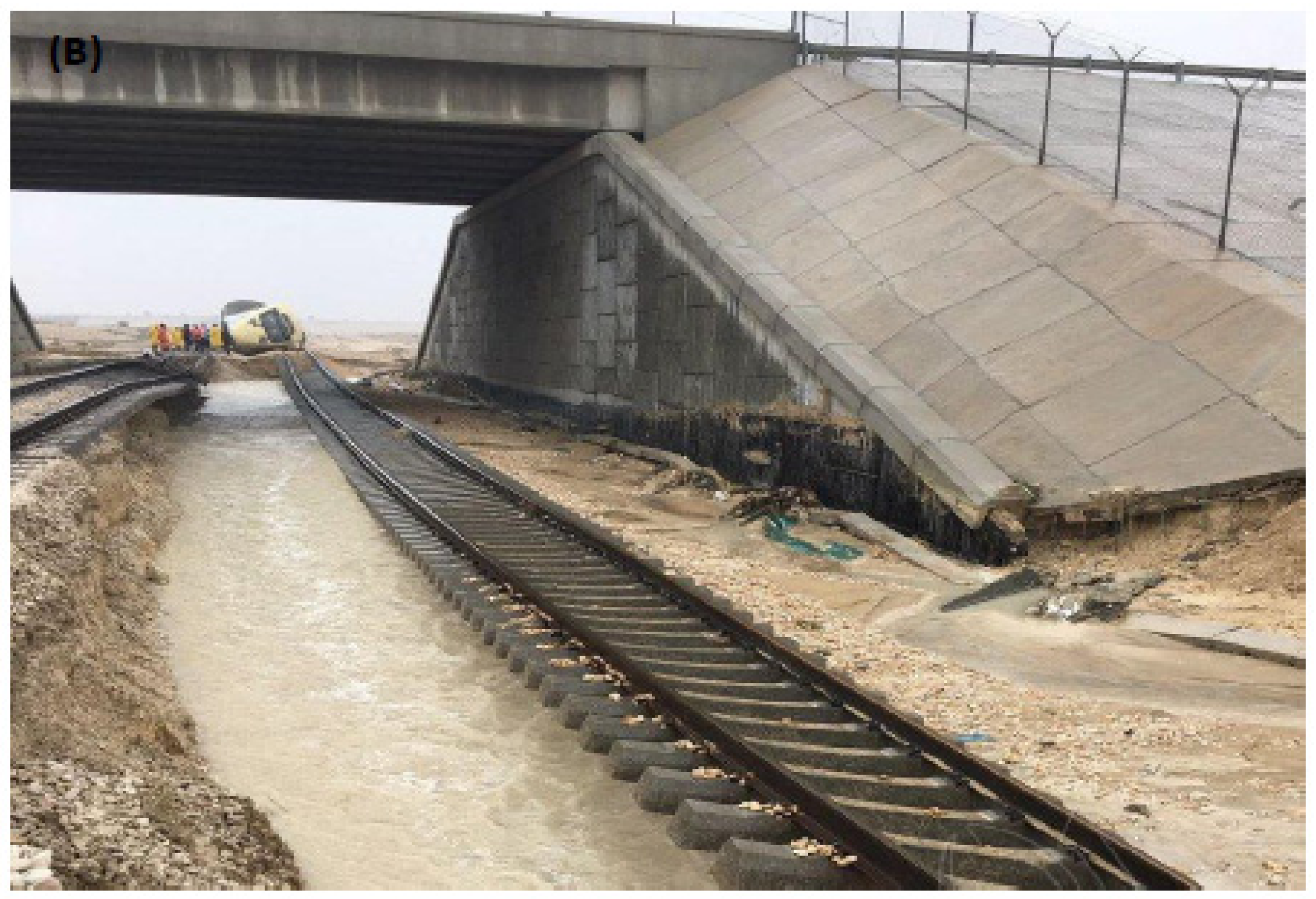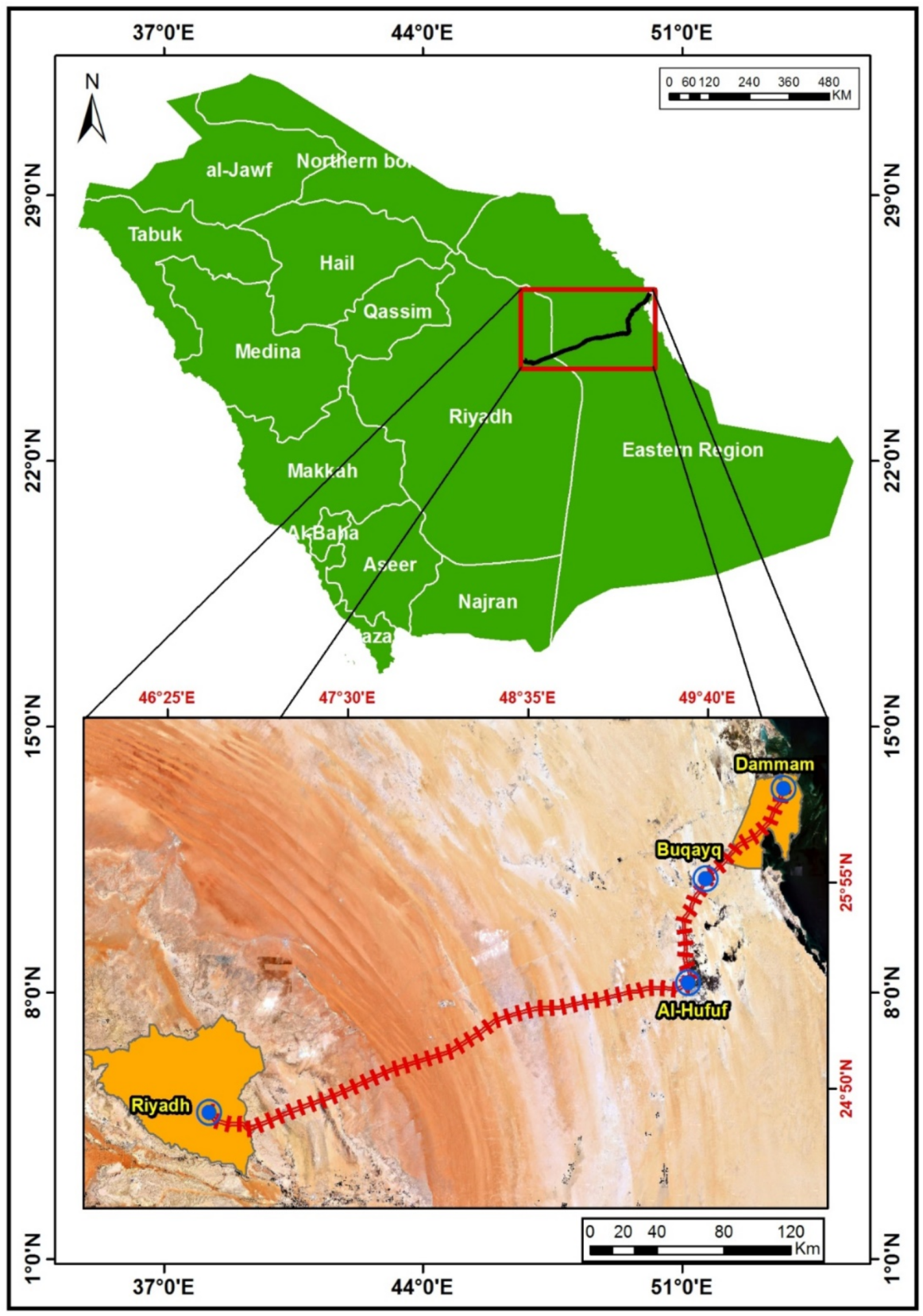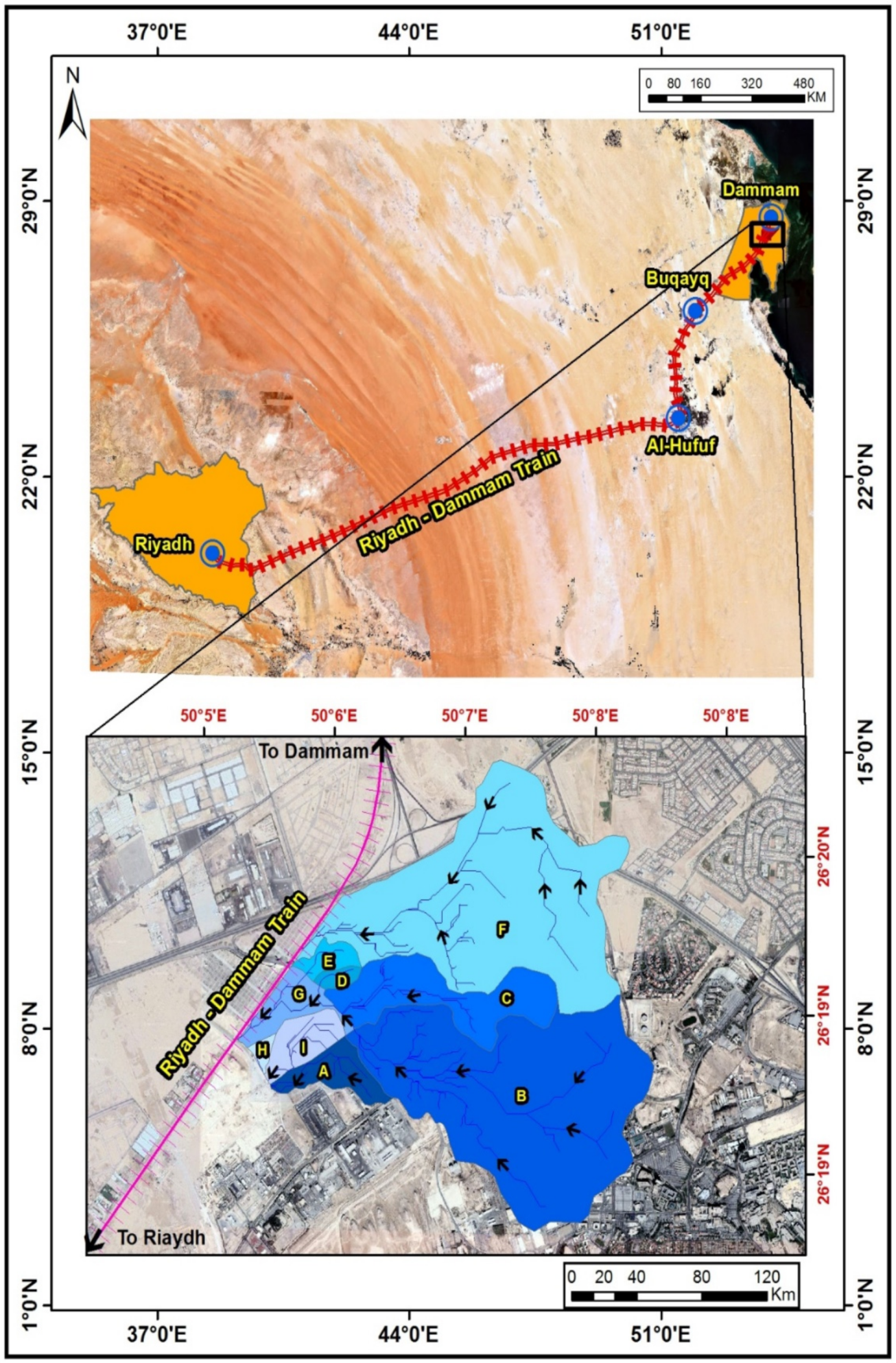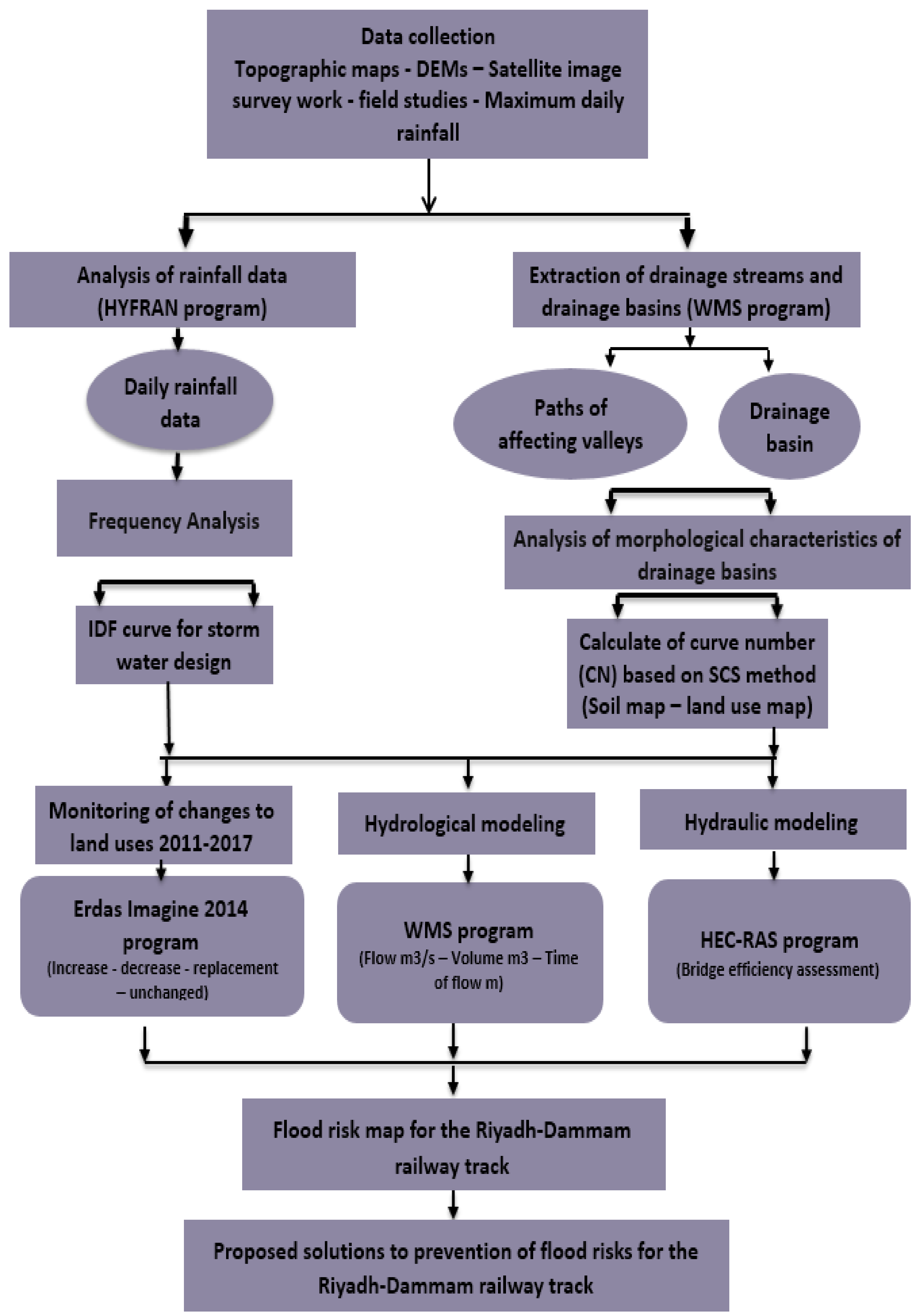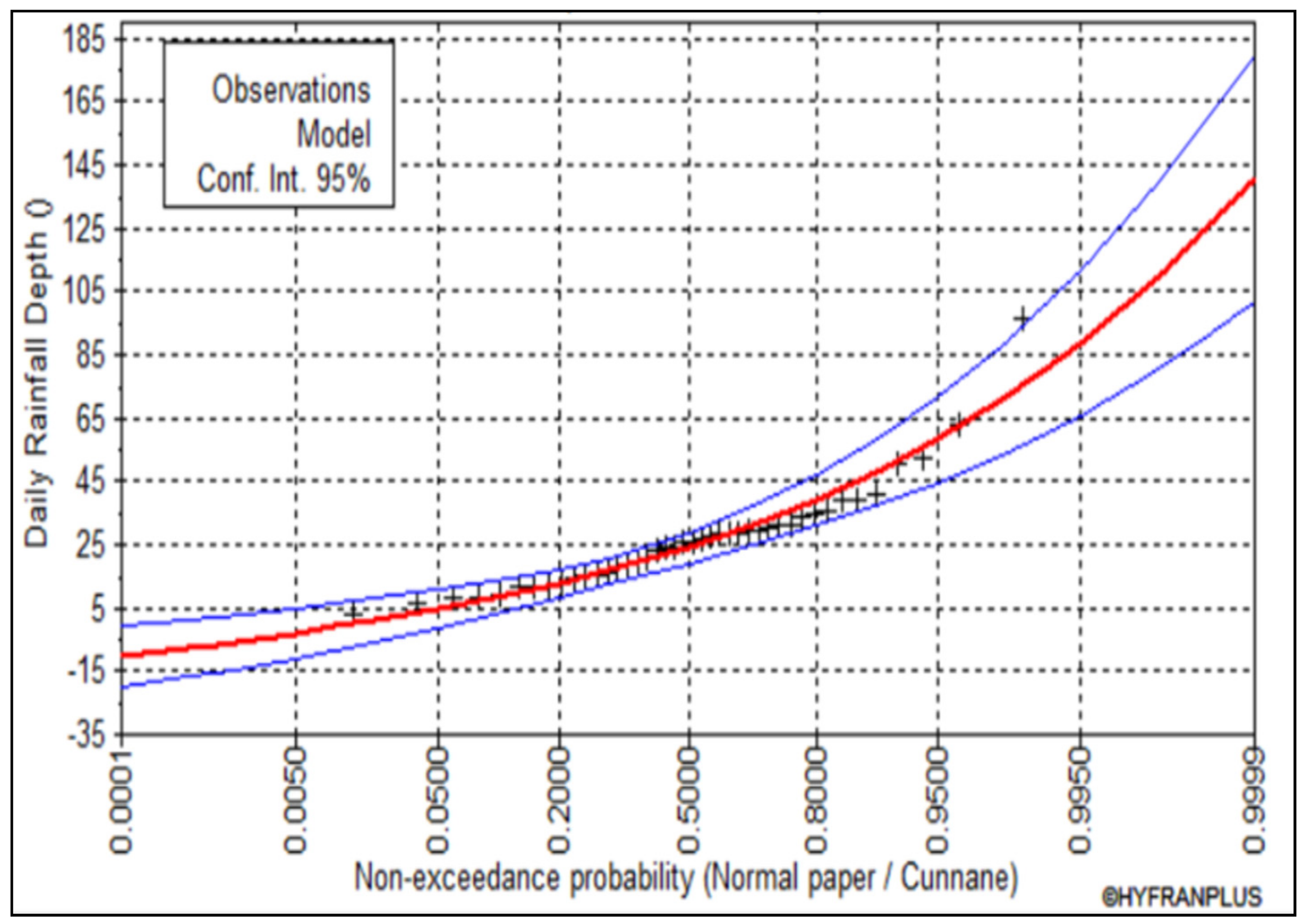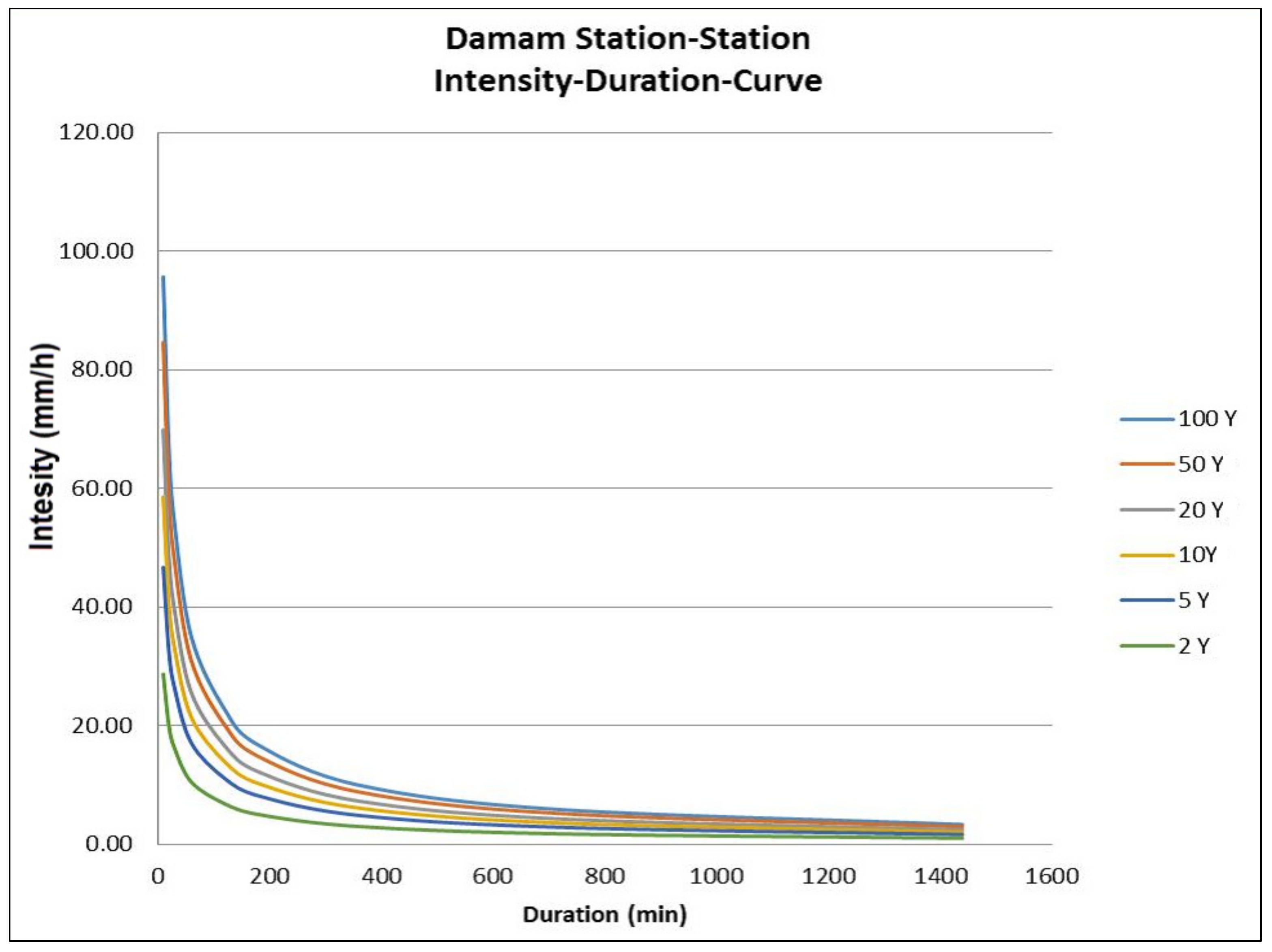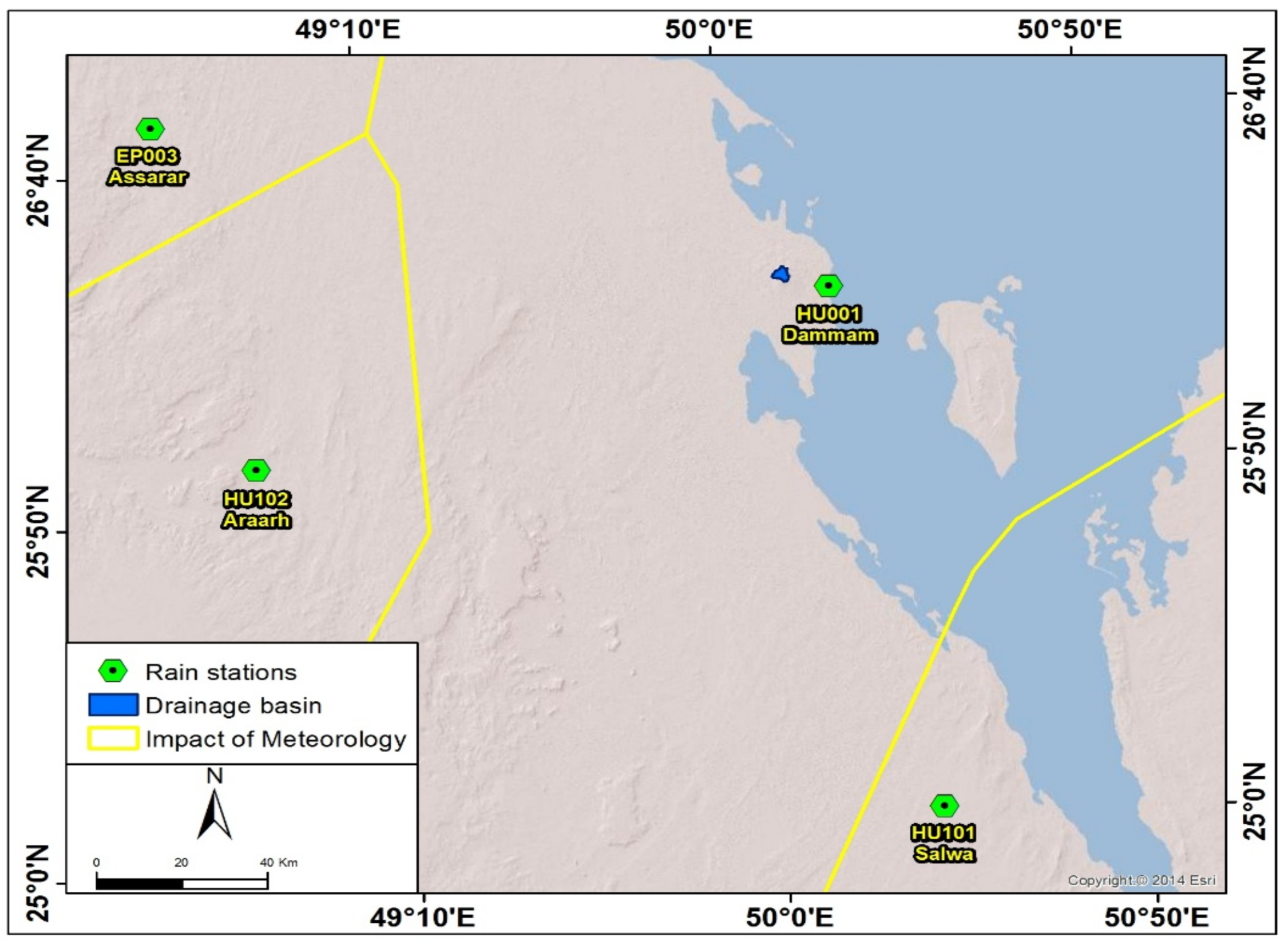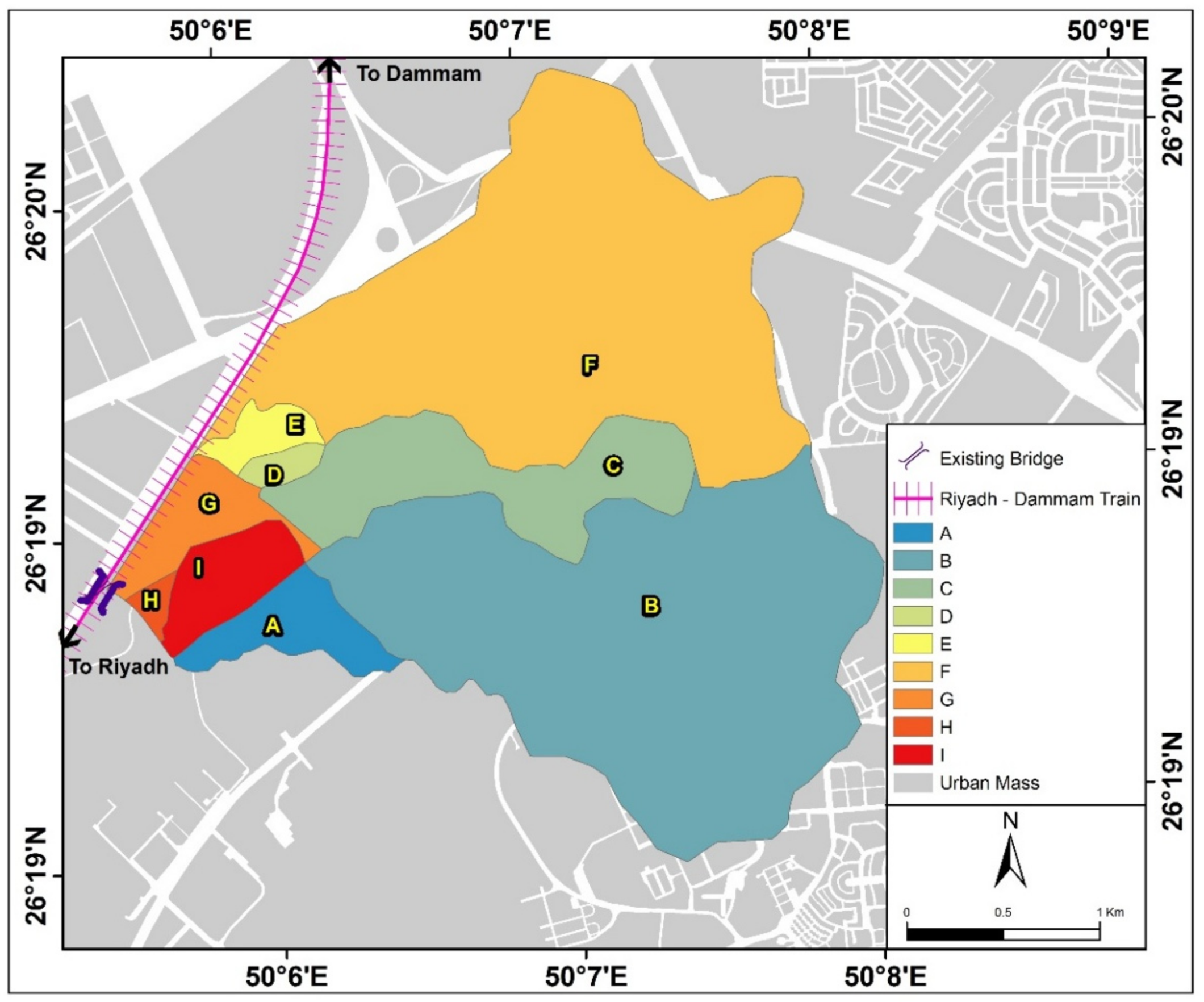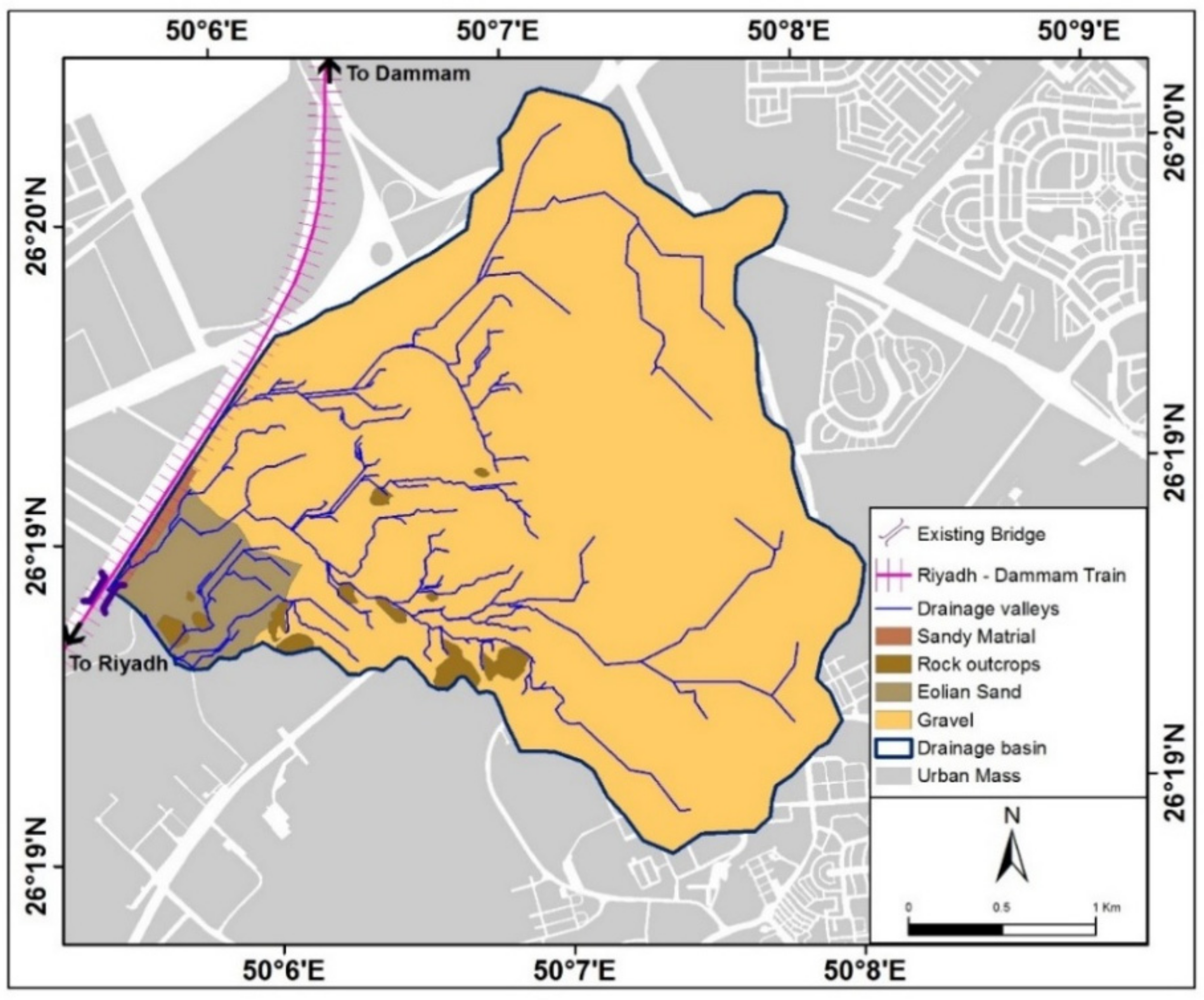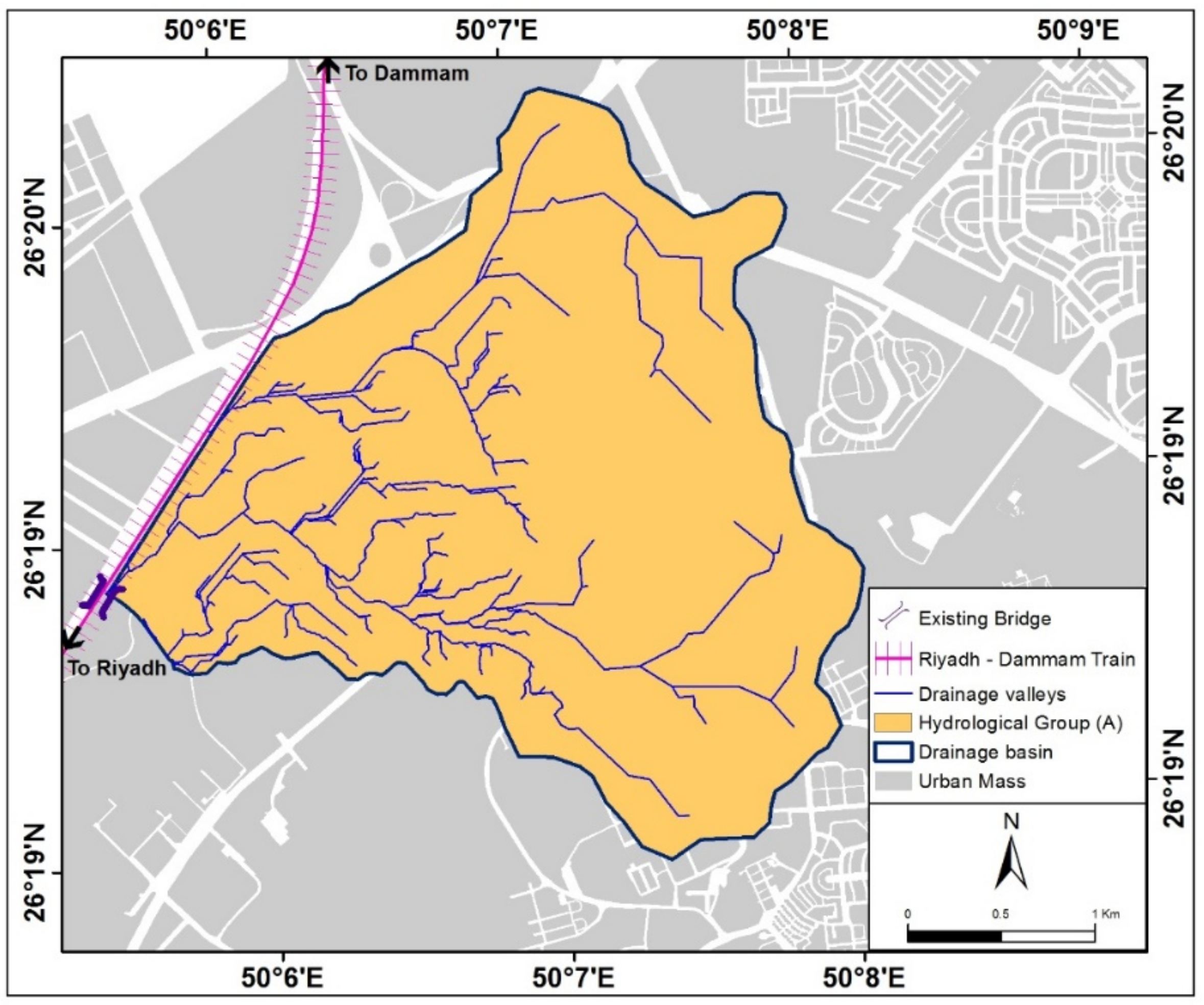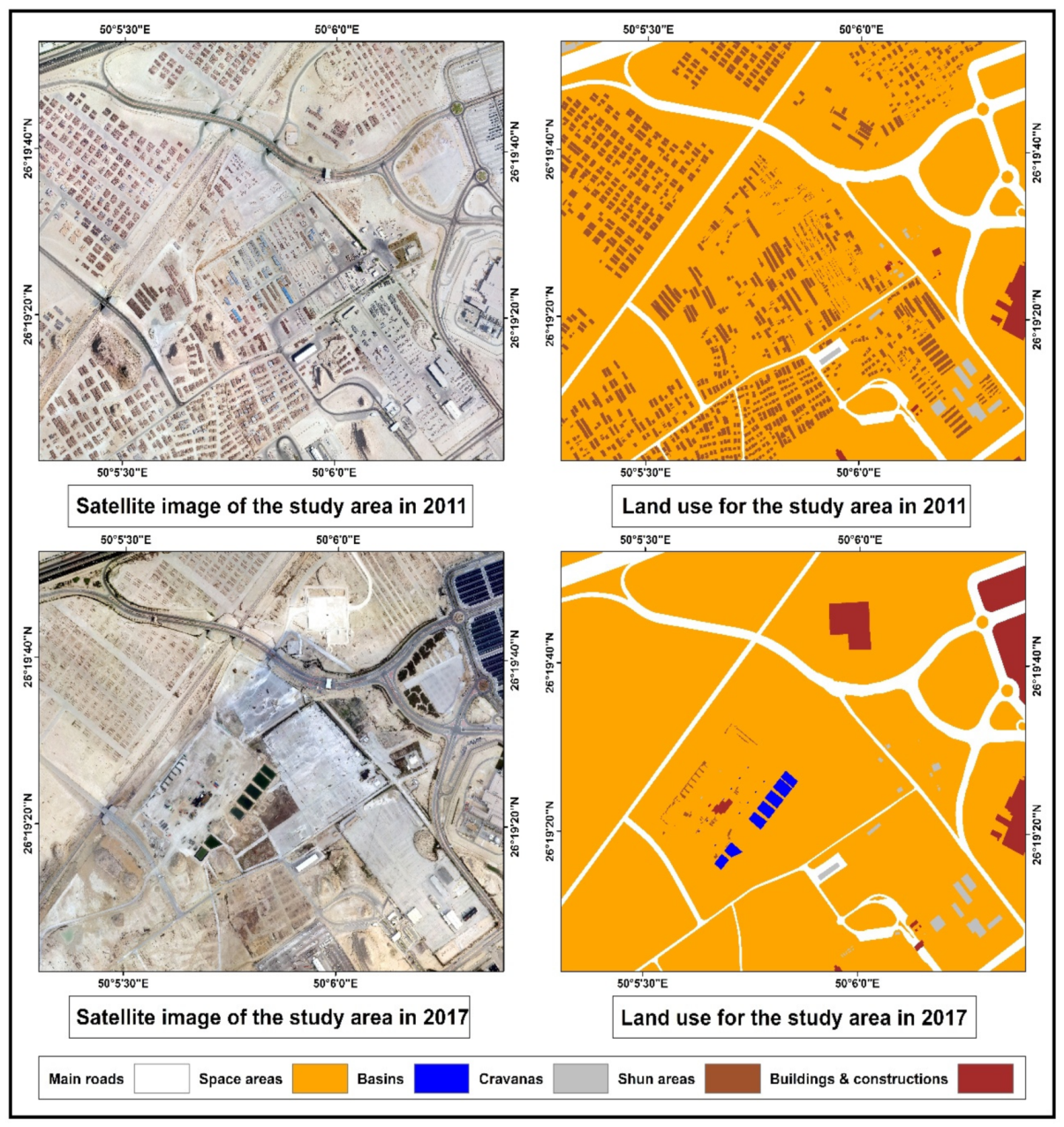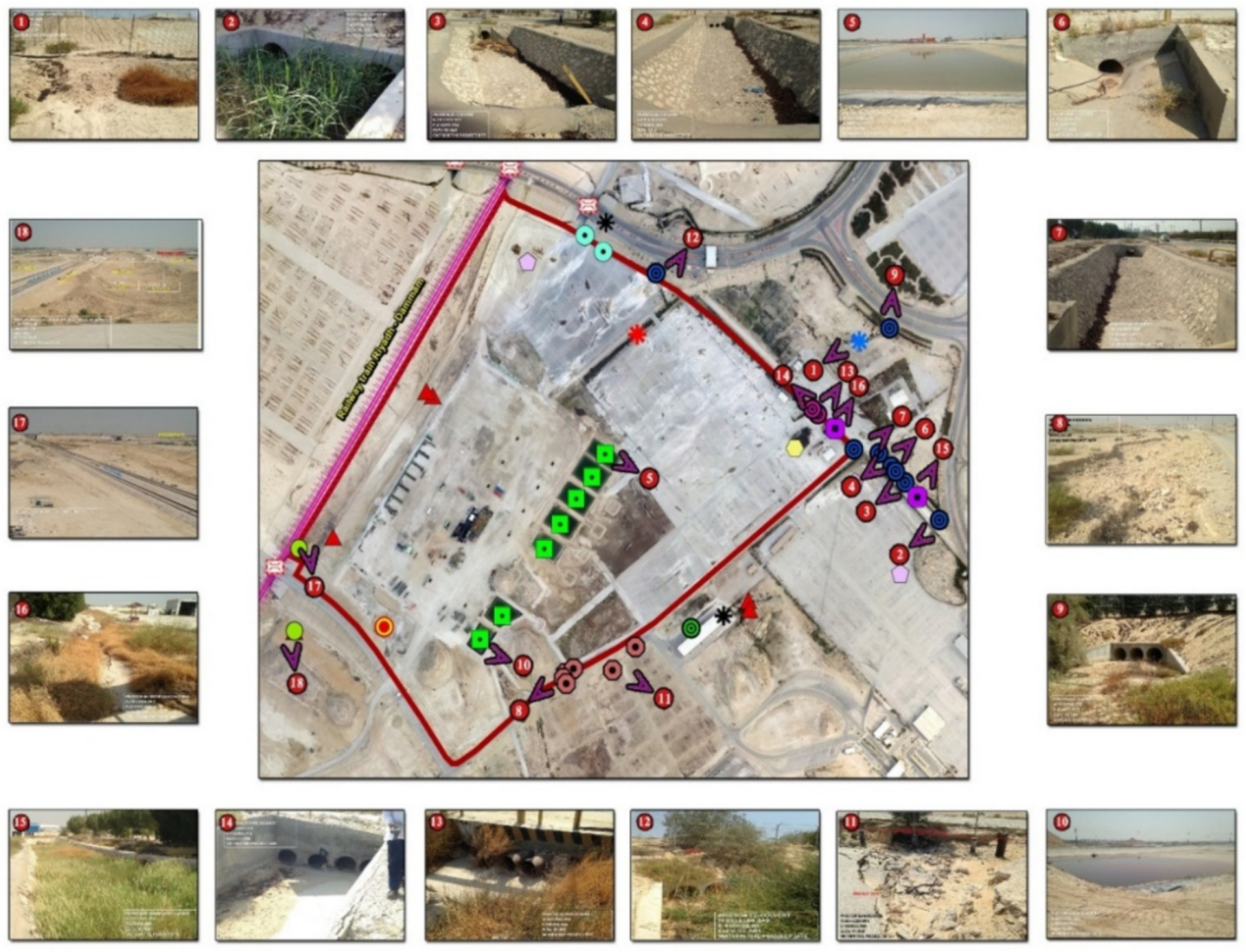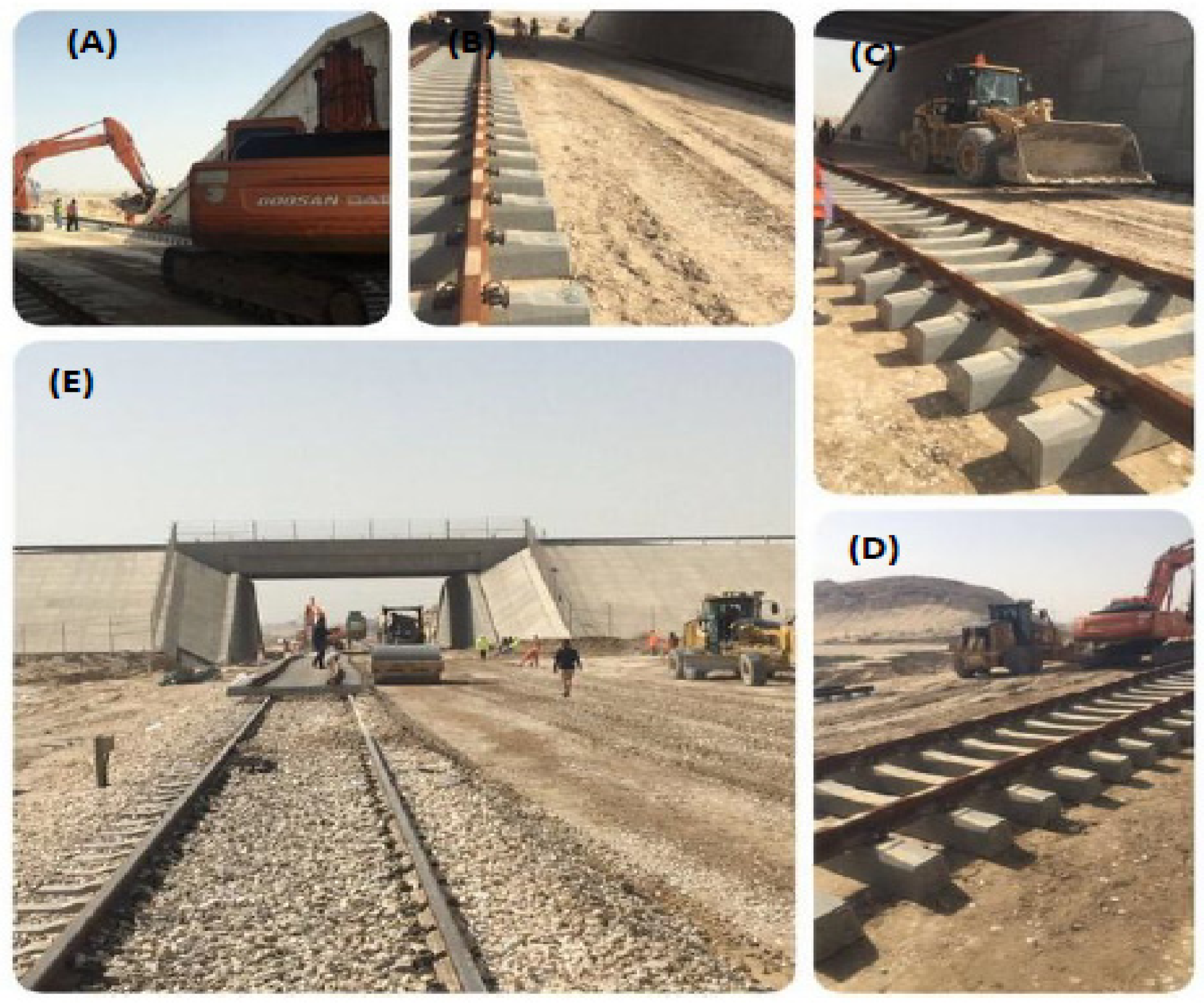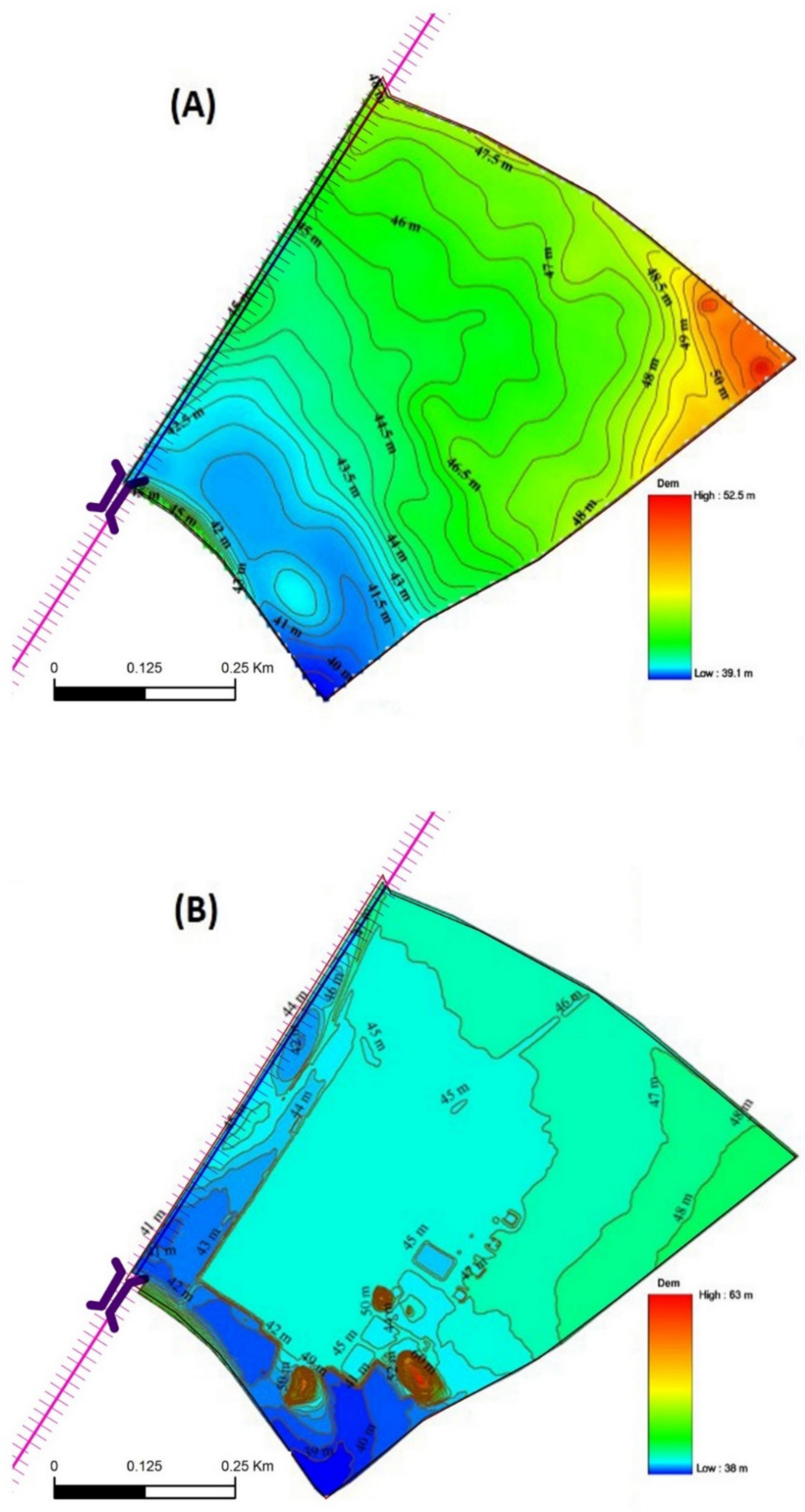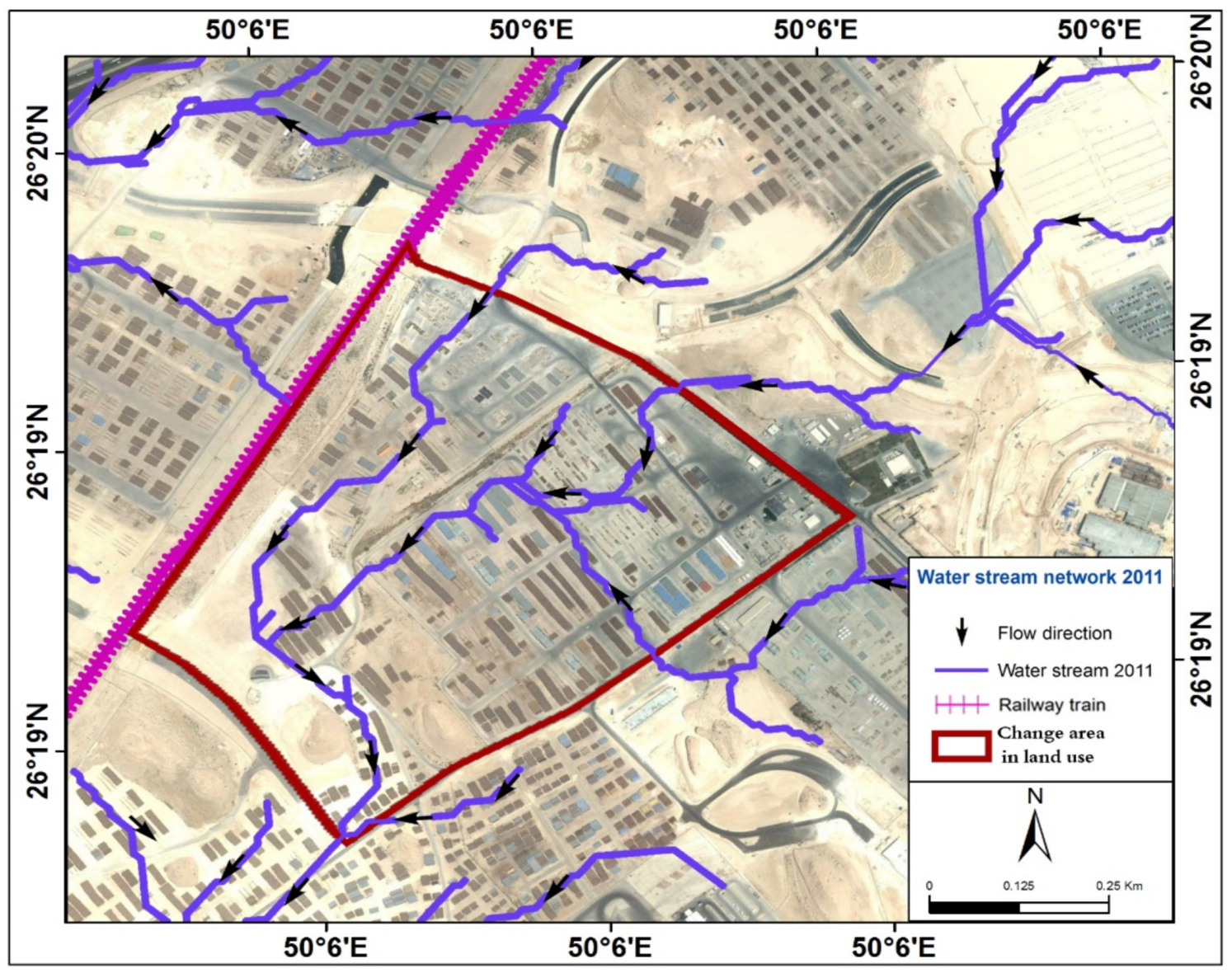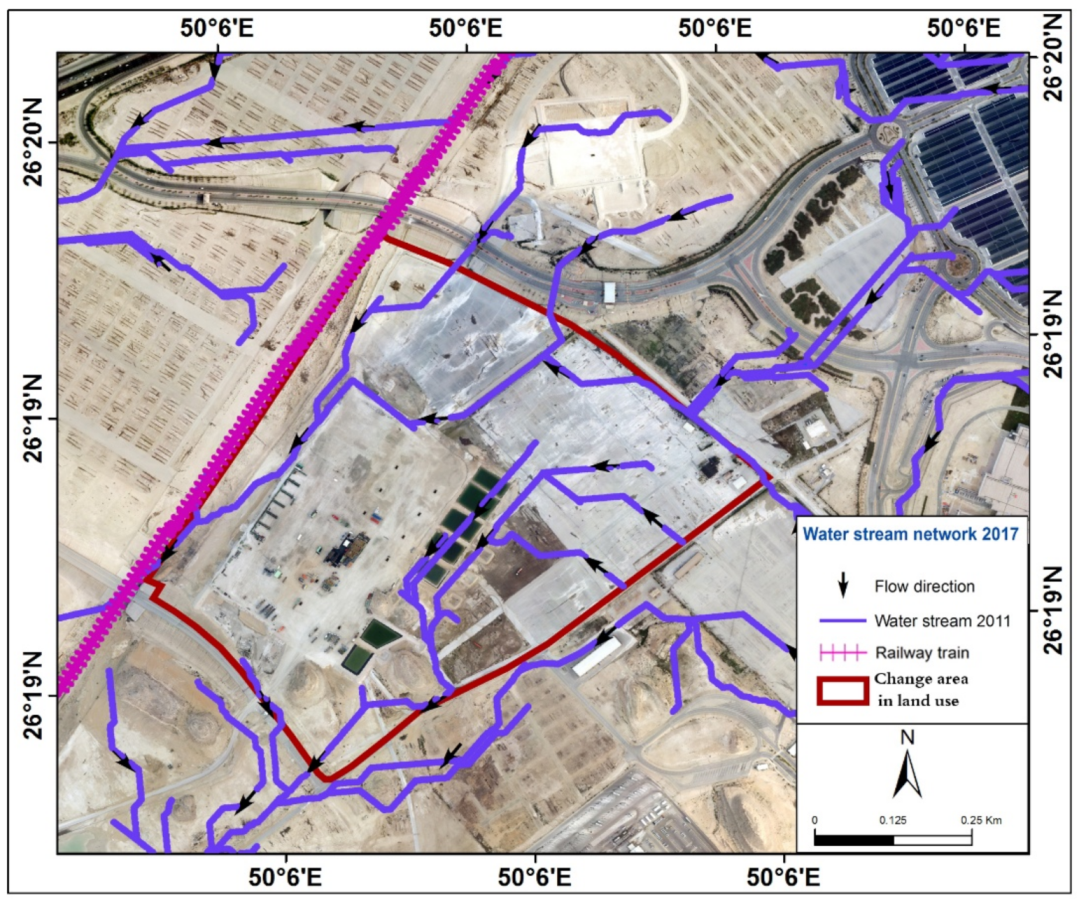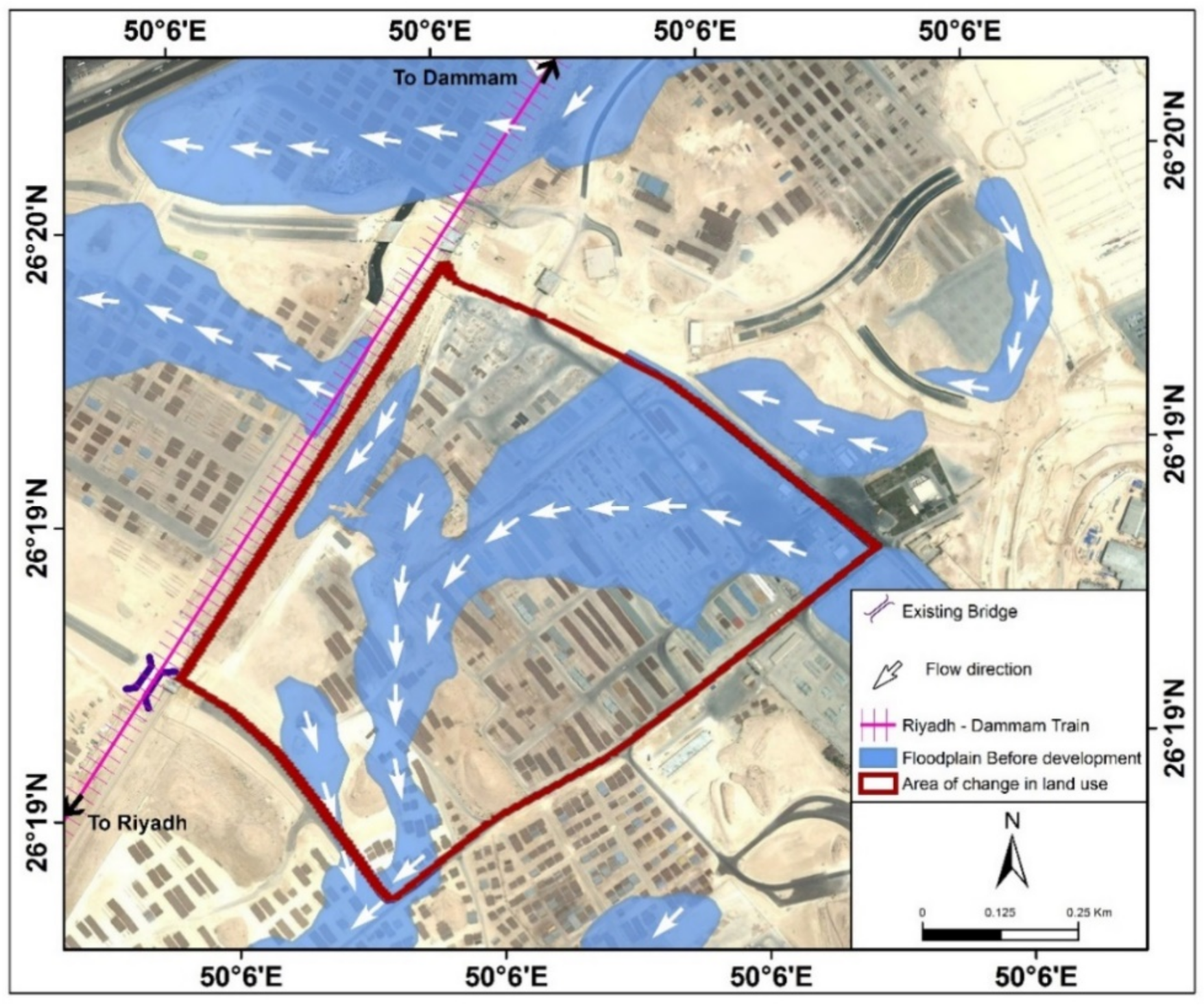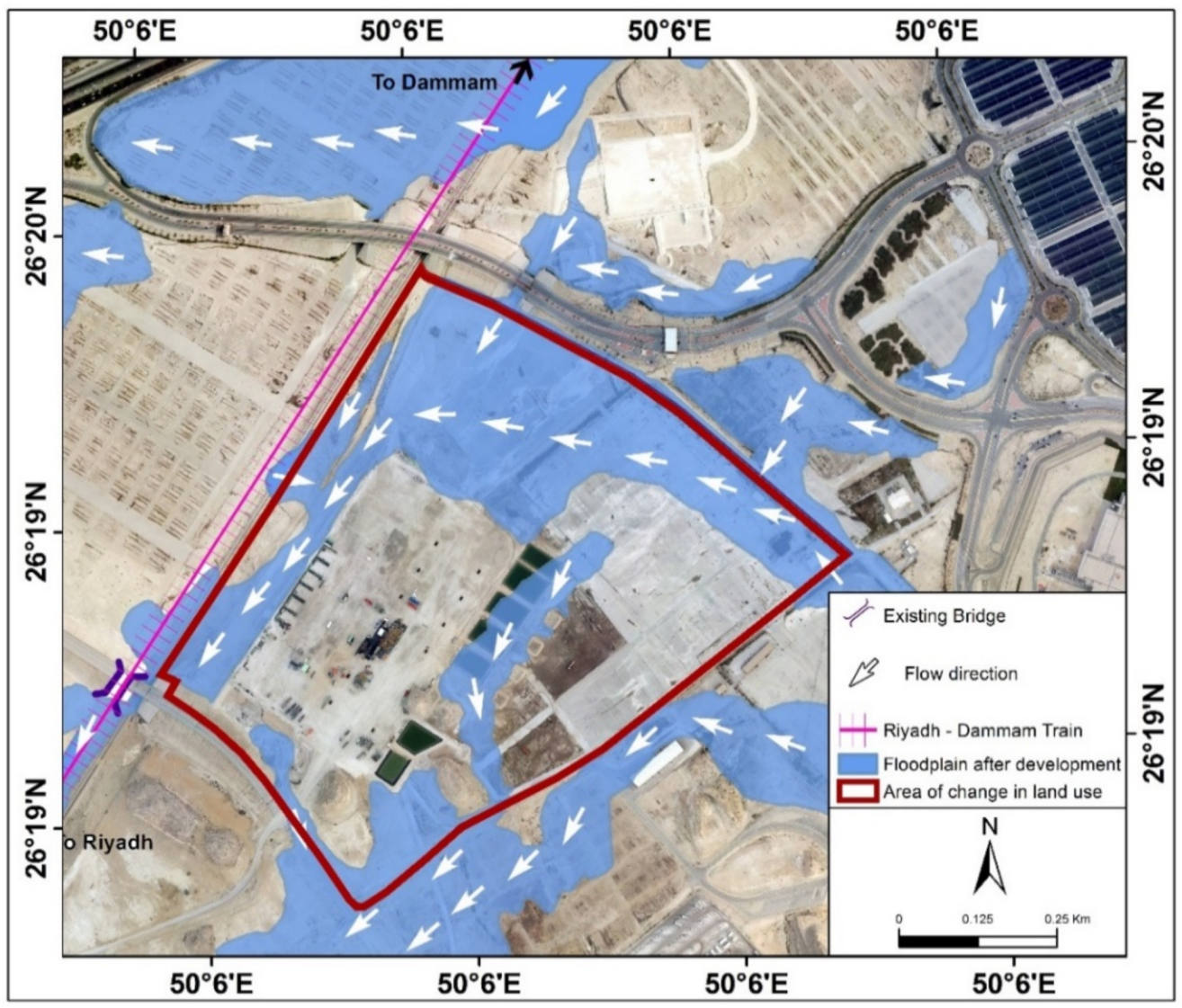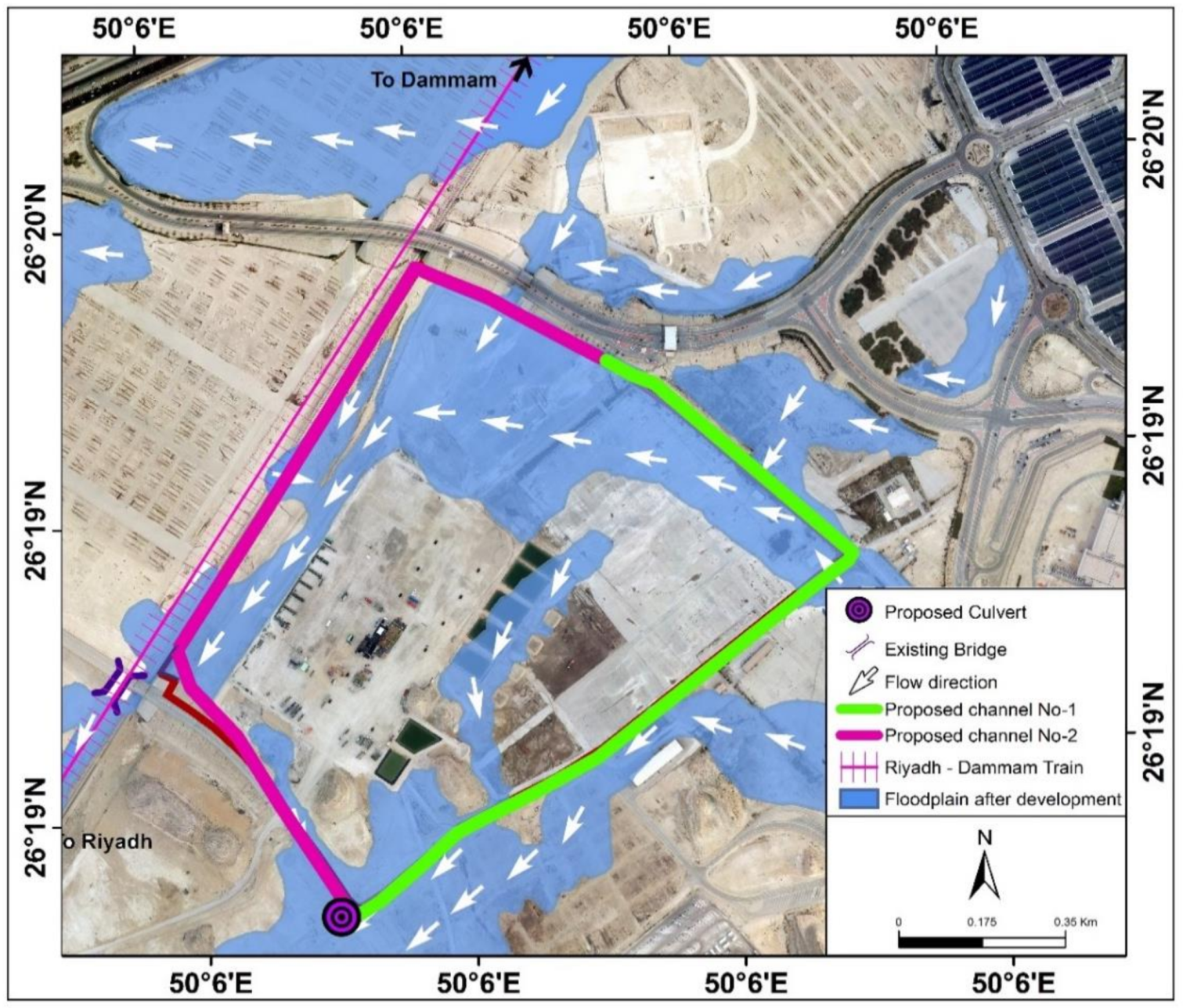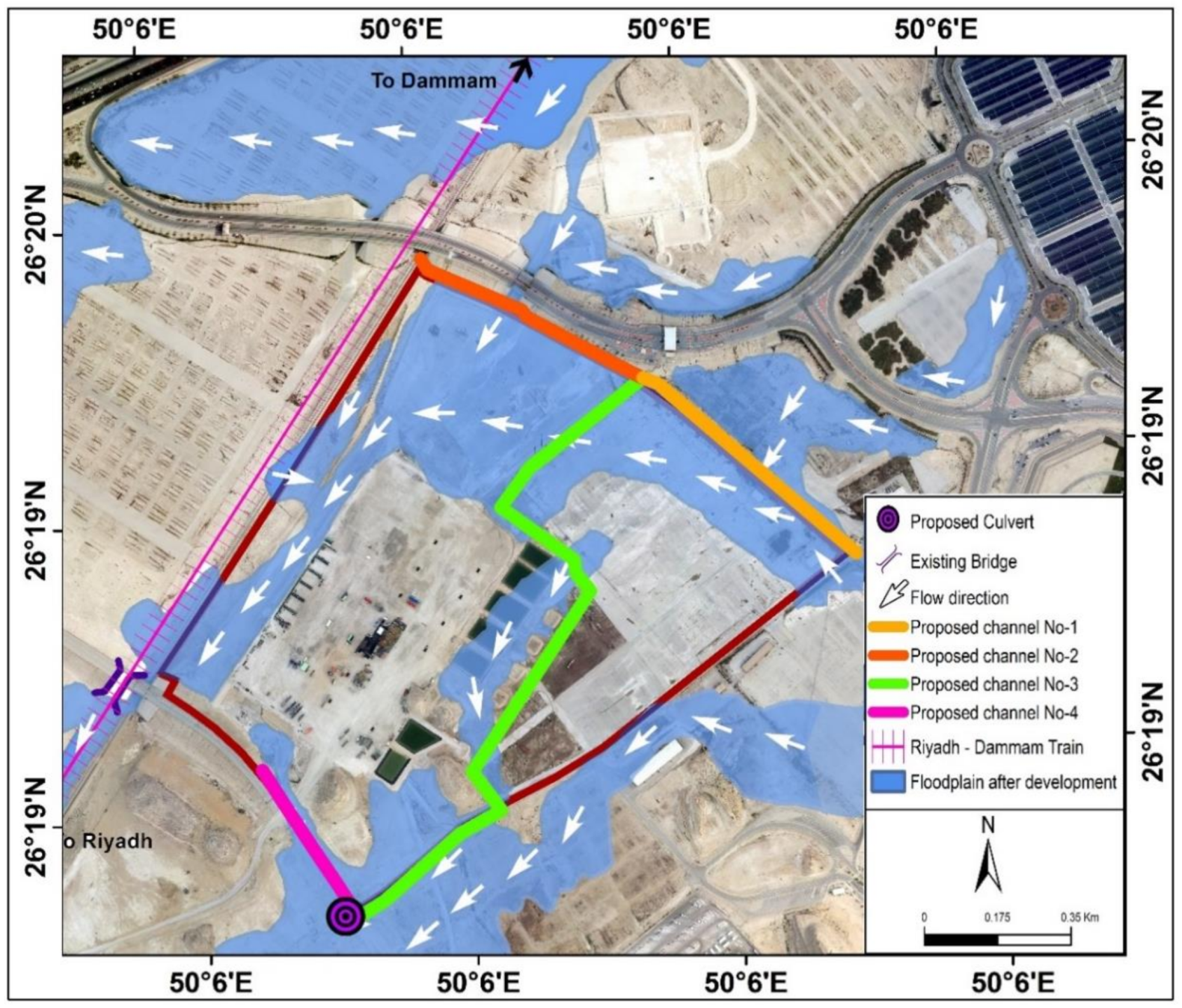1. Introduction
Land-use changes play an important role in the hydrological behavior of drainage basins and affect the local hydrological cycle. Several studies have been conducted to assess the impact of land-use changes on runoff [
1,
2,
3,
4,
5]. Land use and land cover changes are affected by attempts to meet human needs such as in the construction of residential, industrial, and agricultural facilities, mining, as well as other infrastructure facilities that are key processes associated with economic and sustainable growth of the area [
6]. The proper use of available land is essential for improving the economic and planning status of the area without expanding to areas prone to risk, which is an essential issue for sustainable planning [
6,
7]. Urban flooding has been, and continues to be, a major problem for many cities throughout the developed and developing world. The need to formulate a sound flood management policy driven by knowledge of the frequency and magnitude of these floods is essential to improve the impacts of these floods. Flood risk maps can be used by design engineers as an effective tool for water resources and urban planning to assess the vulnerability of the infrastructure and residents of that area to flood events [
8].
The record of flood events registered between 1950 and 2017 indicates that most floods have occurred in recent decades. About 2% of floods occurred during the 1950s and increased rapidly every decade thereafter to about 3.9%, 6.6%, 13.2%, 21.9%, and 52.2% for the sixties, seventies, eighties, nineties, and the millennium, respectively. Floods accounted for more than two-thirds of the hydrological disasters during the period from 2012 to 2014 and reached 90.9% during the period from 2015 to 2016. More than 60% of total economic and human losses took place during the period from 1950 to 2016 in Asia. In Saudi Arabia, floods were characterized as one of the most frequent and devastating natural disasters [
9].
Many authors acknowledged the fact that increased urban activities in flood areas will increase peak discharge, reduce peak time, and increase surface runoff [
10,
11,
12,
13,
14]. A better understanding and assessment of land-use changes that have a direct impact on watershed hydrological processes is critical to the planning, management, and sustainable development of watersheds [
15,
16,
17,
18]. Recently, geomatics of remote sensing (RS) and geographic information systems (GIS) have been employed as powerful and effective tools for determining land-use changes [
19,
20].
Hydrological models used for peak estimation and hydrographic calculations have evolved in line with the spatial information sources provided by RS and GIS techniques. The Watershed Modeling System (WMS) provides an advanced graphical environment for building a great number of mathematical models used in hydrological and hydraulic calculations, which can be classified into six main models: hydrological (HEC-HMS, HEC-1), hydraulic (HEC–RAS, HY-8), rain drainage networks (EPA-SWMM, XP-SWMM), water quality analysis (EPANET), water quality (HSPF, CE-QUAL-W2), and two-dimensional hydrological models (GSSHA).
The importance of remote sensing is demonstrated by its superior ability to provide abundant Earth information that plays an important role in continuous observations of the Earth and its various resources [
21,
22,
23,
24,
25]. Satellite images are key documents that help produce maps in both paper and digital spatial distributions. For terrestrial components in a broad framework [
26,
27,
28,
29], remote-sensing technology and GIS, combined with appropriate models of rainwater flow, provide ideal tools for estimating the volume of direct water flow and peak discharge volume as well as provide a source for water charts [
30]. For model input parameters, satellite data can provide us with local information on land use, soil, vegetation, drainage, etc., in conjunction with traditionally measured climate parameters, and also help to study rapidly changing phenomena such as floods. Flood spatial information technologies, particularly geographic information systems and remote sensing (RS) technologies, have proven to be effective tools in monitoring changes in land use [
31,
32,
33]. In determining drainage patterns and in water resource planning, GIS programs have been widely used in several geomorphological, environmental, and flood management and environmental applications [
34,
35,
36].
Flood risk mapping and risk analysis of any of the drainage basins involves several factors or criteria [
37,
38]. The geographic information system (GIS) and remote sensing (RS) applications have contributed significantly to the analysis of natural hazards [
39,
40]. Over the past few decades, researchers have been involved in developing different methods and models for natural hazard mapping using RS and GIS technologies [
41,
42], including frequency [
43,
44], analytical hierarchy [
45], fuzzy logic [
46], logistic regression [
47], artificial neural networks [
48,
49,
50], evidence weights [
51], multi-standard resolution [
52,
53], and hydraulic modeling, which are essential for flood risk management and mitigation [
9,
54,
55,
56,
57,
58,
59].
Many researchers have addressed the problems of sudden flood risk in different parts of the world in many studies. Khubat and others [
60] made a comparative assessment of flood susceptibility modeling in one of China’s most flood-prone areas, the Ningdu Catchment, using multi-criteria decision-making analyses and machine-learning methods. Three multi-criteria decision-making (MCDM) analysis techniques (VIKOR, TOPSIS, and SAW), along with two machine-learning methods (NBT and NB), were tested for their ability to model flood susceptibility. Wang and others [
61] investigated the use of a novel hybrid technique by integrating a multi-criteria decision analysis and geographic information system to evaluate flood susceptibility mapping (FSM) in a case study in Shangyou County, China.
Sharma and others [
62] used a multi-standard analysis for flood risk assessment of the Kubili River Basin, Assam, India, where a multi-criteria analysis approach (MCA) was introduced to describe the effective use of geospatial techniques for disaster risk reduction at the village level, in order to produce a map of flood-prone areas. Salish and others [
63] analyzed the vulnerability of flooding surrounding the Markham River in the Province of Murubi in Papua New Guinea by creating a reasonable sensitivity map of floods. Khabat and others [
64] assessed the vulnerability of flooding based on GIS and the establishment of flood vulnerability maps using four models: flood frequency rate (FR), weights (WofE), the analytic hierarchy process (AHP), and a method combining both the frequency rate and analytic hierarchy process methods (FR–AHP). Moreover, they compared the severity of flooding and bivariate statistical models with the use of multi-standard analysis techniques. Getahun and Gebre [
65] used GIS techniques and the HEC–RAS hydraulic model to assess the risk of flooding and to map the flooded areas in the Awash River basin in the State of Ethiopia. In this study, the flooded areas along the Awash River were mapped for different return periods based on the highest flows.
Olga and others [
66] assessed the risk of flooding in river basin areas in the Murky region in Greece by processing information of seven criteria using multi-criteria analysis in the GIS environment in order to determine flood risk areas within the river basin. Determination of weights for each criterion was carried out using hierarchical analysis (AHP). Clement and Edward [
67] used GIS applications, remote sensing, and serial hierarchical analysis of Accra flood modeling through the production of a flood risk map. Martin and others [
68] used a flood risk index, based on remote sensing and GIS technology, to describe the risk of flooding in areas where data are scarce, taking into account slope, flow accumulation, drainage network density, distance from drainage channel, geology, land use/cover, rainfall intensity, and the factors causing floods in order to produce a flood risk map. The study of Karim et al. [
9] applied a new approach to identify urban areas exposed to the risk of the floods in the city of Tabuk, with the recommendation of utilizing a mechanism for flood prevention and city protection through the integration of hydrological modeling.
Data from [
69] indicated that the natural disasters that occurred in Saudi Arabia over the past 15 years (2002–2017) have mostly been floods, and they are expected to recur seven times a year due to rapid urbanization, climate change, and the expansion of cities without clear planning control. Continuous change in the patterns of land uses of Saudi cities at the expense of natural valleys is a serious national problem. What increases the seriousness of this problem in the Saudi Kingdom is that these valleys represent the main places of agricultural, urban services, and economic activities in Saudi cities, thus posing a direct threat to the lives of the population and their economic and service activities. The vast majority of the Kingdom’s cities are in valleys or within low areas where valleys end up.
With the urbanization and expansion of land use along the Riyadh–Dammam train path, as a result of the economic boom witnessed by Saudi Arabia in general and the eastern province, this expansion has led to direct and indirect impacts on the nature of the relationship. Between the land use and dry wadies in the region, urbanization has led to an increase in the rates of meandering, explained by the changes in the streams and tributaries of some wadies in more than one place, as a result of this expansion of land use at the expense of these wadies and tributaries.
These unjust encroachments on the wadies and the change of their paths have contributed to an increase, despite the destructive effects, of floods. This has also led to the adoption of urban plans that do not take into account the paths of the wadies and their reefs, including continuous demolition work by the people and the developers of these schemes, where most of the valleys are exposed. In addition, planning of road networks and railway paths has been carried out without taking into expense the trends and inclinations of wadies and tributaries. This is what happened in the study area, which experienced significant changes in land use that led to a change in the direction of the flow of water. The transformation of its run directly to the path of the Riyadh–Dammam train led to the disaster of the drift of the train.
Figure 1 shows the derailment of the No. 14 Riyadh–Dammam passenger train on 18 February 2017 as a result of the track’s exposure to the torrents of the wadies of the Dil’ Al Midra Al Janubi and from the change of land uses in the region. About 18 people were injured, 193 passengers were transported to Dammam city by a reserve train, and the route of the damaged line was closed while the General Railway Corporation began its task to look for the causes of the disaster.
In this study, an innovative approach was used to measure the effective impact of changes in the land use and morphology on the high risk of floods in order to reveal the sustainability of the railway facility. Analyses were conducted with the Riyadh–Dammam train line, Saudi Arabia. Analyses were based on the combination of GIS, remote sensing (RS), and water basin modelling systems (WMS), as well as the hydrological modelling program of the Hydrological Engineers Program (HEC–HMS) and HEC–RAS river analysis system, The proposed planning policies and recommendations will contribute to understanding the nature of floods in these environments that have undergone dynamic changes, which cannot be analyzed using old maps and traditional methods, and alternative preventive measures have been proposed in the study area to help mitigate the effects of sudden floods of the Dil’ Al Midra Al Janubi wadi that led to the train disaster.
6. Conclusions
Sustainable development of the study area has been threatened by ignoring integrated maps of flood hazards, which represent historical changes in the land cover of the Riyadh–Dammam train crash area. The Riyadh–Dammam train track has been exposed to the risks of floods that have caused much damage to life, property, and infrastructure and have led to the flooding of nearby urban complexes.
This mainly is due to the limitations of unbalanced urban development, especially imposed interventions in changing the use of land for planning purposes. The study area witnessed changes in the use of land, the most prominent of which was the increase in the area of construction buildings by 292%, from 2.5 hectares in 2011 to 9.8 hectares in 2017. In 2017, the land-use map also saw the construction of seven storage basins, with an area of 1.5 hectares. The second thing was the increase in the height of the natural land levels in the center of the area almost as a result of the filling operations and the construction of a concrete layer in preparation for the construction of storage basins. Notably, the facilities that have been developed have raised the level of land in the middle part by at least 1 to 2 m.
The third mater is the morphology of the shape of the wadies between 2011 and 2017. In terms of the direction of the flow path, the intensity of discharge to the north instead of the south, and the presence of erosion to the south of the study site, there is evidence of geomorphological changes indicating the intensity of the discharge in the study area that is cut off by transit waterways.
The fourth mater is revealed by the results of the hydraulic analysis in 2017. The floodwaters did not interrupt or cross the railway track in 2011, but the situation changed after 2017 as the floodwaters interrupted the track in two locations. The first site had a depth of 1.86 m with a speed of 0.43 m/s. The second location was at the corner of the study area on the southwest side with a depth of 0.57 m and a speed of 4.91 m/s.
The fifth mater is that there are many existing hydraulic structures (ferries, bridges, and canals) that flow directly towards the train track. The study area has become a collection point for water coming from the southeast and northeast, which is extremely dangerous, and is coupled with the inability of drainage facilities to remove water. The existing flood waters of bridges located below the north train track pass peak flows to the wadies affecting them, resulting in significant damage to the train, property, and personnel.
There is no doubt that these major changes played a crucial role in the change of morphology of land use and was a clear point of objection in the way of wadies becoming a large part of the direction of flow. Flow is heading towards the northwest, i.e., towards the train track. This is possibly the real danger and is the main reason for the change of water flow from the Southern Side of Dil’ Al Midra Al Janubi wadi, which caused the Riyadh–Dammam train to drift on 18 February 2017 at kilo (10) in the west of Dhahran neighborhood.
Thus, this poses a schematic question: to what extent is the land use map and increased flood risk affected by political decisions taken by the Governmental Authorities over time and by the various development projects that they are implementing? The answer to this question is that managing the problems of urban expansion and land use change, as well as studying the prevention of flood hazards before the preparation of urban plans, have encountered some difficulties in the Kingdom, especially in a city like Dammam in which the disaster of train derailment took place. Knowledge, information, and management expertise in the city of Dammam has not been at the level at which they can be relied upon to address these problems. Moreover, dealing with the challenges of rapid, wide-ranging, inclusive, and varying dimensions and patterns of urban growth, and linking it to the risks of possible flood burdens, is necessary for any government or local administration, regardless of its longevity and experience. This study illustrates the risks of the continuation of urban expansion and land-use change in the valleys, which accelerates the need to pre-plan the cities that grow at the expense of the valleys in the dry areas. Thus, active flood valley routs should be identified, and infringements on them should be prevented. Therefore, the study presented a suggested mechanism to prevent the dangers of floods on the route of the Riyadh–Dammam train, which is suitable based on its spatial and urban nature. This mechanism should be adhered to in order to manage the urban environment in light of recurring flood incidents.
The present study will be an important criterion for planners and policymakers in Saudi Arabia as well as researchers in land-use change and flood risk prevention, as its vision and outputs can serve as key inputs for sustainable land use plans and strategies to mitigate flood risk. Moreover, the study represents an applied model for the management of the infrastructure against flood risks, and it is a critical approach to the assessment of flood risks of the infrastructure of railway tracks.
